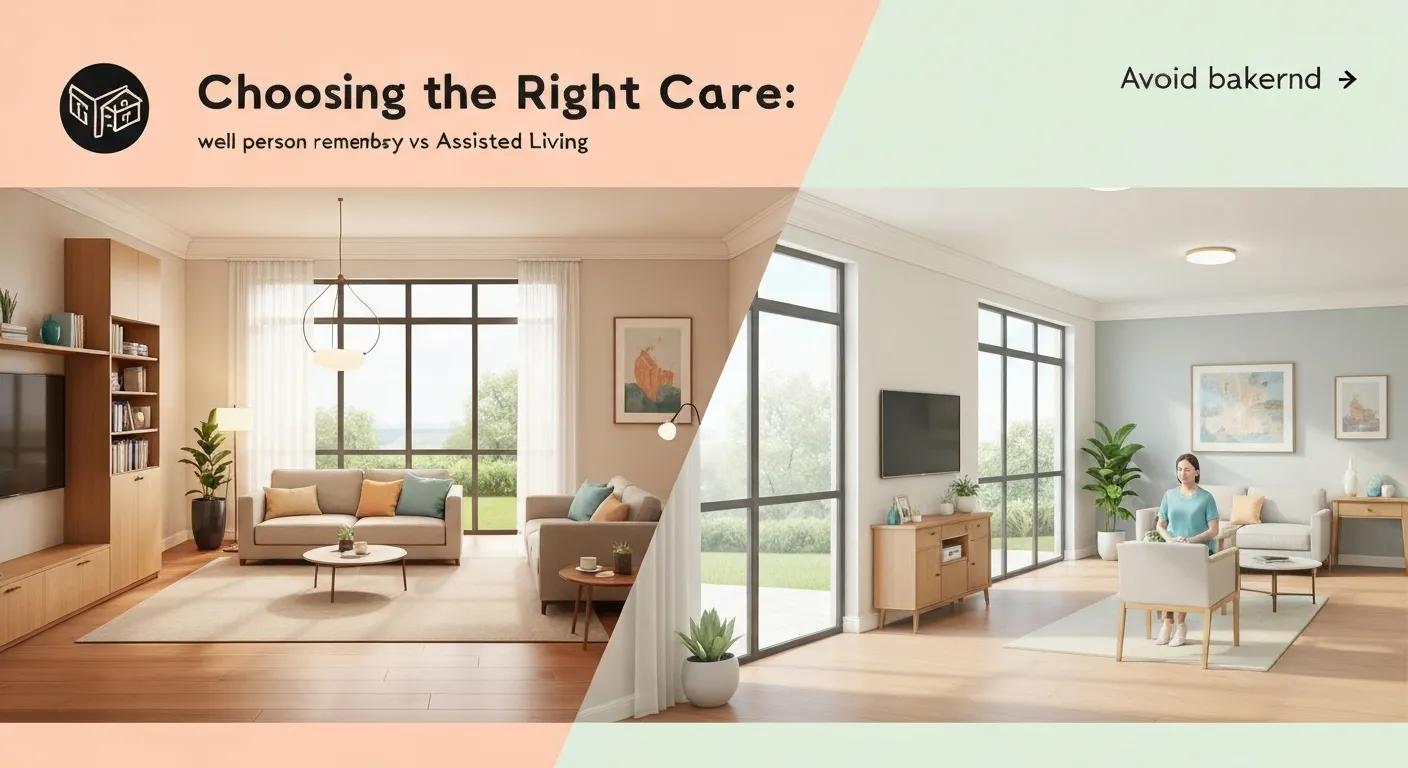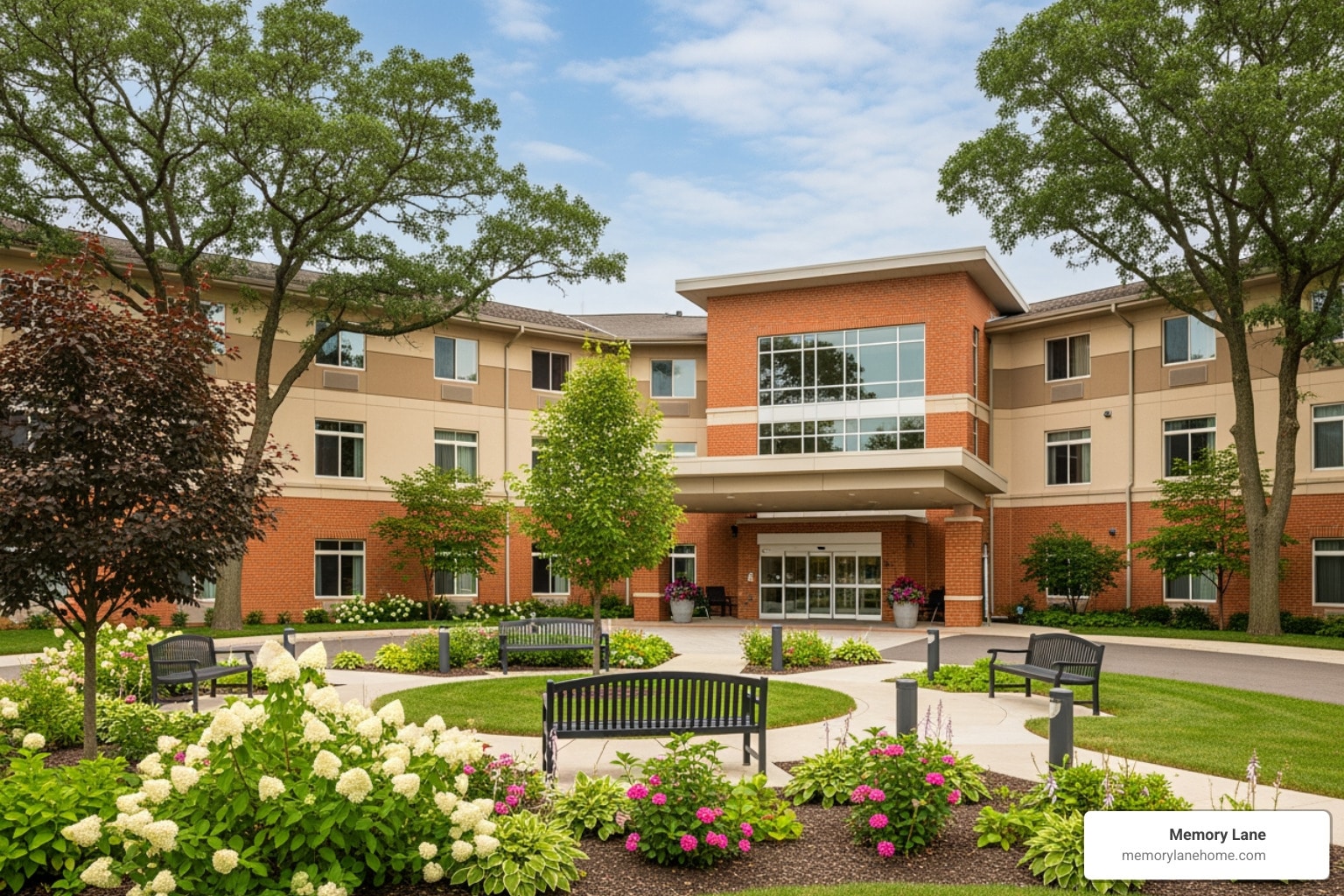Navigating dementia care at home vs nursing home? Get expert insights on care options, costs, and finding the right support.

Memory Care vs Assisted Living: What’s Best?
Memory Care vs Assisted Living: What’s Best?

Memory Care vs Assisted Living: What’s Best for Your Loved One’s Needs?
Deciding between assisted living and memory care often feels overwhelming when searching for “memory care facilities in my area,” especially as families seek a safe, supportive setting for loved ones. Assisted living offers help with daily tasks and social engagement, while memory care provides specialized dementia support in secured environments. This guide explores definitions, benefits, costs, safety features and decision-making factors to help you compare these two senior care services. You’ll discover who benefits most from assisted living, which situations call for memory care, key differences in staff training and security, signs it’s time to transition, and practical steps for choosing the right option. Along the way, you’ll learn how Memory Lane Assisted Living in Ypsilanti and Ann Arbor delivers a home-like environment, high caregiver-to-resident ratios and personalized dementia care as part of its assisted living framework.
What Is Assisted Living and Who Benefits from It?
Assisted living is a residential care option designed to support seniors who need help with everyday activities while maintaining as much independence as possible. This service type provides assistance with Activities of Daily Living (ADLs) such as dressing, bathing and medication management, combined with social opportunities that promote well-being. Seniors who still enjoy personal autonomy yet require a safety net for routine tasks benefit most from this model. Families choosing assisted living often seek a community atmosphere where loved ones can share meals, participate in events and receive professional care when needed.
Offering a balance between personal freedom and practical support, assisted living addresses the needs of older adults who may struggle with mobility or chronic conditions but remain cognitively intact. As seniors age, daily chores like housekeeping and laundry can become hazards; assisted living facilities handle these responsibilities to reduce risk. Residents typically live in private or semi-private apartments within a community setting, fostering socialization and peer engagement. Understanding these basic elements lays the foundation for comparing how memory care diverges to meet specialized dementia needs.
What Services Does Assisted Living Provide for Seniors?
Assisted living facilities deliver a range of services that cater to residents’ daily and medical requirements.
- Personal care assistance for dressing, bathing and grooming.
- Medication management overseen by trained staff to ensure correct dosing.
- Housekeeping, laundry and maintenance to maintain a safe environment.
- Nutritious meals served in communal dining areas to foster social interaction.
- Transportation services for medical appointments, shopping and community outings.
These services reduce stress on families while allowing seniors to enjoy a predictable routine and the dignity of choice. The combination of practical help and social engagement supports physical health and mental well-being, preparing families to explore how independence thrives in assisted living.
How Does Assisted Living Support Senior Independence?
Assisted living enhances autonomy by tailoring support levels to each resident’s abilities. From minimal daily reminders to full hands-on care, personalized care plans ensure that residents receive only the assistance they require. Engaging in scheduled activities, residents maintain cognitive sharpness and self-esteem while staff monitor safety and intervene when necessary. For example, medication reminders promote adherence without undermining personal responsibility. This supportive autonomy model transitions naturally into understanding why memory care emphasizes structured supervision for seniors experiencing cognitive decline.
What Amenities and Social Activities Are Common in Assisted Living?
Communal living in assisted living facilities often includes amenities designed to enrich daily life and encourage community bonding.
These shared experiences foster friendships and structure, helping residents feel part of a community. Recognizing the social and recreational strengths of assisted living primes you to see how memory care modifies these offerings for cognitive support.
What Is Memory Care and Who Needs Specialized Dementia Support?
Memory care is a specialized long-term care service tailored to individuals living with Alzheimer’s disease or other forms of dementia. It provides a secure, structured environment with 24/7 supervision, specifically designed to reduce confusion and prevent wandering. Residents benefit from staff trained in dementia-focused techniques, personalized routines and therapeutic programs that address cognitive decline. For families facing progressive memory loss in loved ones, memory care offers targeted interventions that safety-proof the setting and maintain quality of life.
The memory care approach contrasts with assisted living by prioritizing cognitive support, safety and routine consistency. While assisted living serves broadly independent seniors, memory care caters to those whose cognitive impairment poses daily risks or behavioral challenges. Understanding this distinction leads into the specialized elements that set memory care apart.
What Makes Memory Care Different from Assisted Living?
Memory care integrates environmental modifications, therapeutic programming and enhanced supervision to meet dementia-related needs.
- Secure units with controlled access to prevent wandering.
- Dementia-trained staff skilled in de-escalation, redirection and memory cues.
- Customized routines that minimize confusion by maintaining familiar patterns.
- Sensory gardens and memory walls that reinforce recognition and comfort.
- Technology-assisted monitoring systems for real-time safety alerts.
These features create a protective atmosphere where residents can navigate daily life with reassurance, laying the groundwork for identifying who should consider this level of care.
Who Should Consider Memory Care for Alzheimer’s or Dementia?
Seniors exhibiting the following signs often require the structured support of memory care:
- Frequent wandering or attempts to leave living areas unaccompanied.
- Difficulty managing basic ADLs due to memory lapses or confusion.
- Significant behavioral changes such as aggression, sundowning or repeated distress.
- Increased risk of falls or accidents due to disorientation.
- Inability to recognize familiar faces or surroundings.
When cognitive impairment compromises safety and independence, memory care provides the environment and expert attention necessary to reduce risks and maintain dignity. This context prepares families to explore the therapeutic programs central to quality dementia care.
What Therapeutic Activities and Programs Are Offered in Memory Care?
Memory care programs focus on cognitive stimulation, emotional well-being and physical engagement through structured activities.
By addressing body and mind, these programs foster a sense of purpose and connectivity. The emphasis on therapeutic engagement highlights why comparing core differences with assisted living is essential.
What Are the Key Differences Between Memory Care and Assisted Living?
Assessing assisted living versus memory care involves comparing care levels, safety measures, staff expertise, program offerings and costs. A clear contrast helps families determine which environment best matches their loved one’s needs.
This side-by-side summary defines how each model addresses daily living and cognitive health. With this foundation, families can delve deeper into each comparison category.
How Do Levels of Care Differ Between Memory Care and Assisted Living?
Assisted living focuses on helping residents maintain independence through assistance with ADLs and general health monitoring. Memory care intensifies this support by incorporating dementia-specific strategies such as consistent cueing, redirection techniques and specialized behavior management. The enhanced care level in memory care responds directly to progressive cognitive decline and safety concerns that go beyond the scope of traditional assisted living.
What Safety and Security Features Distinguish Memory Care?
Memory care units employ advanced security to safeguard residents prone to wandering or confusion. Secure entry-exit points, coded doors, motion sensors and 24/7 supervision reduce elopement risks. In contrast, assisted living offers monitored but less restrictive access, suitable for seniors with intact judgment. These distinct safety measures ensure memory care residents remain protected within a familiar footprint.
How Do Staff Training and Caregiver Ratios Compare?
Staff in assisted living typically receive broad training in senior care, covering ADL assistance, CPR and medication protocols, with a resident ratio of about one caregiver for every six residents during the day. Memory care staff complete specialized dementia certification programs and practice evidence-based engagement techniques, supported by a higher daytime ratio of one caregiver for every three residents. This intensified staffing model enables personalized attention and rapid response to cognitive or behavioral changes.
What Are the Differences in Activities and Social Programs?
Assisted living emphasizes social engagement through community-wide events, fitness classes and hobby groups. Memory care adapts these activities into smaller, structured sessions that reinforce memory, cognition and emotional stability. Sensory stations, individualized music playlists and thematic memory walls guide residents through familiar experiences. By tailoring programs to cognitive needs, memory care ensures therapeutic value alongside social interaction.
How Does the Cost of Memory Care Compare to Assisted Living?
Memory care typically carries a 15–25 percent premium over assisted living due to specialized staffing, secured environments and therapeutic programming. In 2025, the national average for assisted living is projected at $5,676 per month, whereas memory care averages around $6,450 per month. Geographic factors can push prices above $8,000 in certain regions. Families should weigh these costs against the level of supervision and tailored support required for dementia care.
What Are the Signs That Indicate It’s Time for Memory Care?
Recognizing when to transition from assisted living or home care to memory care hinges on observing safety, functional and caregiver stress indicators. Early identification of these signs helps ensure timely access to specialized support.
Monitoring these indicators enables families to act before emergencies occur.
Understanding these triggers leads to exploring how specific concerns impact care decisions.
What Behavioral and Safety Concerns Signal Need for Memory Care?
Frequent wandering, aggressive outbursts or repeated disorientation are clear signals that standard assisted living or home support may not suffice. Memory care’s secure design and behavior management expertise directly address these challenges. Families noticing these patterns should consider the specialized supervision that memory care provides.
How Does Decline in Daily Living Skills Affect Care Decisions?
When a loved one struggles to bathe, dress or manage medications safely, the risk of injury and health complications increases. Memory care teams use structured routines and assistive technologies to maintain hygiene and adherence, reducing accidents. Such functional decline often marks the point where dementia-focused support becomes essential.
When Does Caregiver Burnout Suggest Transitioning to Memory Care?
Caregiver exhaustion, emotional stress and physical strain can compromise the quality of home care. Memory care relieves families by offering professional 24/7 supervision, personalized activities and consistent routines. Recognizing burnout as a sign to transition ensures both resident safety and family well-being.
How Does Memory Lane Assisted Living Provide Unique Memory Care in Ypsilanti and Ann Arbor?
Memory Lane Assisted Living specializes in integrating memory care within a small-scale assisted living model, operating six-bed ranch houses that simulate a home atmosphere. This residential structure creates familiarity, minimizes institutional stress and strengthens community bonds. Families benefit from a trusted environment where personalized dementia support is seamlessly woven into daily life.
Memory Lane’s approach to memory care exemplifies how environment and staffing converge to support cognitive health. The next sections unpack the home-like features, care ratios and tailored services that distinguish this facility.
What Is the Home-Like Environment at Memory Lane?
Memory Lane’s six-bed ranch homes replicate residential settings with familiar décor, cozy common rooms and personalized living spaces. The scaled-down community feel reduces confusion and promotes comfort for residents with dementia. Family photographs on memory walls and décor that mirrors a private home help reinforce recognition, making transitions smoother and daily life more reassuring.
How Does Memory Lane’s High Caregiver-to-Resident Ratio Benefit Residents?
With a daytime ratio of one caregiver to every three residents and a night ratio of one to six, Memory Lane ensures continuous, individualized attention. This staffing model allows caregivers to notice subtle changes in mood, health or behavior and intervene proactively. Residents receive prompt assistance with ADLs, timely medication administration and immediate support during moments of disorientation.
What Personalized Dementia Care Plans and 24/7 Services Are Offered?
Memory Lane develops customized care plans that align with each resident’s history, preferences and cognitive needs. Plans incorporate reminiscence activities, sensory sessions and structured daily schedules. Around-the-clock supervision guarantees safety, while dementia-trained staff employ validation therapy and memory cues to maintain engagement. This perpetual support network both safeguards residents and provides families with peace of mind.
How to Choose Between Memory Care and Assisted Living for Your Loved One?
Selecting the right care option involves evaluating individual needs, environment suitability and long-term goals. By assessing cognitive status, physical abilities and emotional well-being, families can match services to requirements. Touring facilities and accessing expert resources further aids informed decision-making.
What Factors Should Families Consider When Choosing Care?
Families should weigh the following criteria when comparing care options:
- Level of Cognitive Impairment – Determine if memory loss affects daily safety.
- Physical Health Needs – Assess mobility, chronic conditions and ADL assistance requirements.
- Social and Therapeutic Preferences – Identify desired activities and engagement levels.
- Environment and Atmosphere – Consider home-like settings versus larger community models.
- Budget and Cost Structure – Compare monthly fees, care inclusions and unexpected charges.
Balancing these factors enables families to align care services with loved ones’ evolving needs.
How Can Touring Facilities Help in Making the Right Choice?
Visiting potential communities allows families to evaluate staff interactions, observe daily routines and experience the environment firsthand. Asking targeted questions—such as emergency protocols, staff training credentials and family involvement opportunities—offers clarity. Personal impressions gathered during tours often reveal nuances that brochures cannot convey.
What Resources Are Available to Support Families in This Decision?
Families can access elder care referral agencies, local aging services and healthcare professionals for guidance on memory care versus assisted living. Educational workshops, support groups and online decision-making tools provide additional perspectives. Consulting geriatric care managers or social workers also ensures comprehensive evaluation of available options.
What Are the Cost Differences Between Memory Care and Assisted Living in 2025?
Understanding financial implications for senior care helps families plan budgets and explore assistance programs. While both services incur monthly fees, memory care’s specialized support and security features typically command higher rates. Comparing average costs provides a realistic framework for projecting long-term expenses.
What Is the Average Monthly Cost of Assisted Living and Memory Care?
In 2025, the national average for assisted living is projected at $5,676 per month, while memory care averages around $6,450 per month. Regional variations in Ypsilanti and Ann Arbor may place assisted living between $4,500 and $7,000, and memory care between $5,200 and $8,000. Understanding these ranges prepares families for realistic budgeting.
Why Is Memory Care Typically More Expensive Than Assisted Living?
Memory care’s premium reflects higher staffing ratios, specialized training, secured environments and therapeutic programming. The cost covers continuous supervision, cognitive support activities and infrastructure to prevent wandering. Assisted living expenses focus on ADL assistance, general health monitoring and community amenities, which require fewer specialized resources.
How Can Families Plan for Memory Care and Assisted Living Expenses?
Families can explore funding through long-term care insurance, veterans’ benefits, state assistance programs and life insurance proceeds. Consulting financial advisors specializing in senior care helps identify tax advantages and resource allocations. Early planning—including evaluating home equity options or setting up care trusts—ensures a sustainable financial strategy for long-term care.
Careful comparison of assisted living and memory care empowers families to make informed choices that balance safety, engagement and cost. By recognizing evolving care needs, touring personalized environments and assessing financial options, loved ones can find the setting that best nurtures independence and dignity. Memory Lane Assisted Living’s home-like ranch houses, high caregiver-to-resident ratios and tailored dementia programs exemplify how integrated memory care within an assisted living framework can provide both familiarity and specialized support.
Memory Care Reduces Nursing Home Admissions for Assisted Living Residents with Dementia
Memory care reduces nursing home admissions among assisted-living residents with dementia. It is possible that memory care provides safer, more person-centered care for memory care to prevent downstream costs of nursing home.
Memory care reduces nursing home admissions among assisted‐living residents with dementia, W Zhang, 2022
Frequently Asked Questions
What are the key indicators that suggest a transition from assisted living to memory care?
Families should look for signs such as increased wandering, difficulty with daily tasks, significant behavioral changes, and cognitive confusion. If a loved one frequently forgets familiar faces or routines, or if their safety is compromised due to disorientation, these are strong indicators that memory care may be necessary. Additionally, caregiver burnout can signal the need for specialized support, as it can affect both the caregiver’s well-being and the quality of care provided.
How can families assess the quality of memory care facilities?
When evaluating memory care facilities, families should consider staff qualifications, caregiver-to-resident ratios, and the types of therapeutic programs offered. Visiting the facility allows families to observe interactions between staff and residents, assess the environment for safety and comfort, and inquire about emergency protocols. Additionally, seeking feedback from current residents’ families can provide valuable insights into the quality of care and overall satisfaction with the facility.
What role do family members play in memory care?
Family members play a crucial role in memory care by providing emotional support and maintaining connections with their loved ones. They can participate in care planning, share personal histories to inform care strategies, and engage in activities with residents. Regular visits can help reinforce familiarity and comfort, which is essential for individuals with dementia. Families should also communicate openly with staff to ensure that care aligns with the resident’s preferences and needs.
What types of training do staff in memory care facilities receive?
Staff in memory care facilities undergo specialized training focused on dementia care techniques, including behavior management, communication strategies, and safety protocols. This training equips caregivers with the skills to handle challenging behaviors, provide emotional support, and implement therapeutic activities that enhance cognitive function. Continuous education and certification in dementia care ensure that staff remain updated on best practices and innovative approaches to support residents effectively.
How do memory care programs address the emotional needs of residents?
Memory care programs often incorporate activities designed to enhance emotional well-being, such as reminiscence therapy, music and art therapy, and sensory stimulation. These activities help evoke positive memories, reduce anxiety, and foster a sense of purpose. By creating a supportive environment that encourages self-expression and social interaction, memory care facilities aim to improve residents’ overall quality of life and emotional health, addressing both cognitive and emotional needs.
What should families consider when budgeting for memory care?
When budgeting for memory care, families should consider the monthly fees, which typically include specialized care, meals, and activities. It’s essential to account for potential additional costs, such as personal care items or therapy sessions. Families should explore funding options like long-term care insurance, veterans’ benefits, and state assistance programs. Consulting with financial advisors who specialize in elder care can help families create a sustainable financial plan for long-term care needs.
Conclusion
Choosing between memory care and assisted living is crucial for ensuring your loved one’s safety and well-being. Each option offers distinct benefits tailored to different needs, from daily assistance to specialized dementia support. By understanding these differences, families can make informed decisions that prioritize both care and comfort. Explore our resources to find the best fit for your loved one today.


